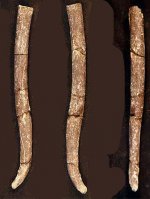Here's a rather unique specimen from the vertebrate paleontological catacombs of the San Bernardino County Museum, California. The photograph below (courtesy a publication issued by a symposium) depicts three different views of the same canid baculum--AKA, dog penile bone--from what vertebrate paleontologists call Aelurodon asthenostylus, an extinct borophagine bone-crushing dog a little larger than a modern coyote.
Needless to report, penile bones (baculae) are only rarely observed as fossils in strata older than the Pleistocene (roughly 2.5 million to 11,000 years ago). The specimen is 10 centimeters long (3.95 inches) and nine millimeters wide (0.354 inch). It's from the middle Miocene Barstow Formation, Mojave Desert, California, from a locality situated approximately 13 meters (about 42 feet) above a prominent layer of volcanic tuff dated through sophisticated radiometric analyses (radioactive isotope determinations) at 14 million years; ergo, the fossil dog penile bone is slightly younger than 14 million years old.
Of course, many modern mammals possess a baculum, including: canids (dogs), felids (cats), procyonids (raccoons, coatis, kinkajous, olingos, olinguitos, ringtails, and cacomistles), bear, pinnipeds (true seals, fur seals, sea lions, and the walrus), rodents, insectivores, bats, and some primates.

For more information on fossils from the middle Miocene Barstow Formation, Mojave Desert, California, see my page: Fossil Insects And Vertebrates On The Mojave Desert, California ; includes a detailed text, with photographs of fossils and on-site pictures, as well.
Needless to report, penile bones (baculae) are only rarely observed as fossils in strata older than the Pleistocene (roughly 2.5 million to 11,000 years ago). The specimen is 10 centimeters long (3.95 inches) and nine millimeters wide (0.354 inch). It's from the middle Miocene Barstow Formation, Mojave Desert, California, from a locality situated approximately 13 meters (about 42 feet) above a prominent layer of volcanic tuff dated through sophisticated radiometric analyses (radioactive isotope determinations) at 14 million years; ergo, the fossil dog penile bone is slightly younger than 14 million years old.
Of course, many modern mammals possess a baculum, including: canids (dogs), felids (cats), procyonids (raccoons, coatis, kinkajous, olingos, olinguitos, ringtails, and cacomistles), bear, pinnipeds (true seals, fur seals, sea lions, and the walrus), rodents, insectivores, bats, and some primates.

For more information on fossils from the middle Miocene Barstow Formation, Mojave Desert, California, see my page: Fossil Insects And Vertebrates On The Mojave Desert, California ; includes a detailed text, with photographs of fossils and on-site pictures, as well.




